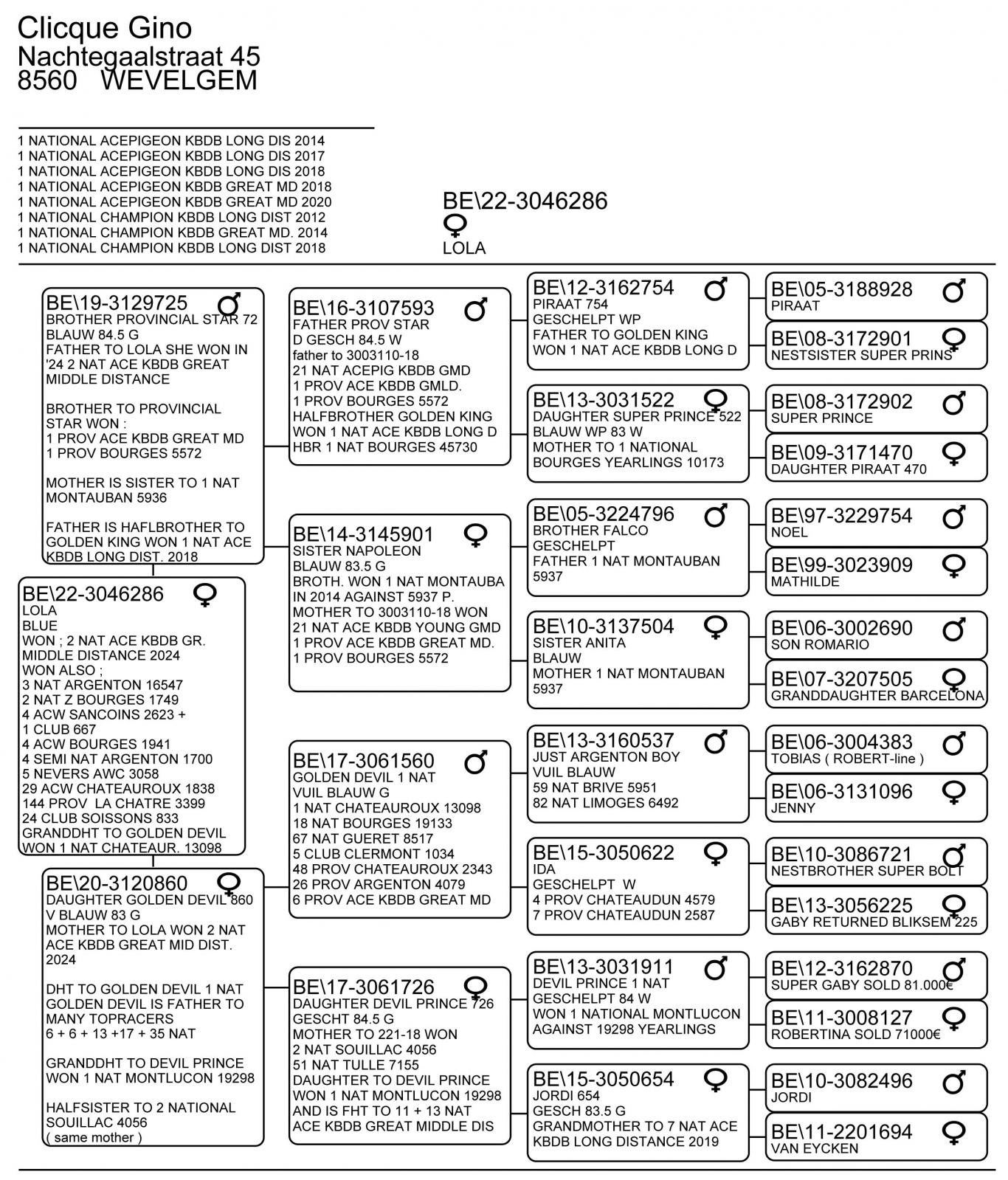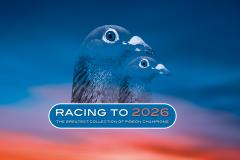Gino Clicque (Wevelgem) 1st National ace KBDB small middle distance youngsters 2024
13 May 2025
Wevelgem: The name Gino Clicque is a regular in the nominations of the national KBDB championships. That his list of honours looks impressive is the least that can be said:
1st National ace great middle distance old birds 2018
1st National ace great middle distance old birds 2020 (raced by Ronny Menten)
1st National ace small middle distance youngsters 2024
1st National champion long-distance old birds 2012
1st National long-distance champion yearlings 2018
1st National champion large middle distance yearlings 2014
1st National ace long-distance yearlings 2014
1st National ace long-distance yearlings 2017
1st National ace long-distance yearlings 2018
The 2024 season was again one to file in the ‘top seasons’ folder because in addition to the national ace pigeon title, 5 provincial wins and no fewer than 51 placings in the Top-100 nationally were won! Few did better.
‘It is the first time I achieved a ranking in the KBDB championships for young pigeons‘ Gino begins his story “it is hen ”Hannah Mae’ (B24-3059539) who in a good month already achieved the 4 necessary top rankings in the small middle distance. To your question whether ‘Hannah Mae’ was specially motivated, I can hardly answer. She sat there watching while her loft mates did make the necessary ‘fun’ on the loft. Behind such performances there is guaranteed to be some kind of motivation but which one I cannot say. Even when she needed 1 more top prize, I left everything as it was. I did not dare to pull some magic trick out of my sleeve. Who knows, it might not have gone completely wrong then.
The national races with the young pigeons remain the main goal of young pigeon racing but there were about five youngsters who achieved great performances on the first middle distance races several weeks in a row. Besides the 1st national ace pigeon title, another youngster won the 13th national ace pigeon title. Unfortunately, I lost it on the last national race from Chateauroux.
Another fact about ‘Hannah Mae’, she was never clocked first. Each time a loft mate was just too fast for her. Once she got all the top results, I didn't give her away anymore. I didn't want to take the risk of losing her.’
Youngsters for the start of the season
‘For the 2025 season, we weaned 260 youngsters for our own use. On 2/12, all the breeders were paired and in 2 rounds all the youngsters were bred.
When the youngsters are weaned, breeding mix is on the menu and remains so for about 3 months.
After 4 weeks they are vaccinated against Rota/Paramyxo for the first time. After 7 to 8 weeks, they are vaccinated the same day against Paramyxo/Herpes and against smallpox (brush). Against parathyphoid is not vaccinated.
When we like the youngsters to start flying better, we adjust the feed and a private mix (made by Van Robaeys) becomes the basic mix. In terms of by-products, we use quality products from Röhnfried. Products such as Avidress, Usne Gano, Avipharm and Gervit W are provided alternately. In fact, during the winter period, we use a fixed schedule for all pigeons. Specifically, on Monday and Tuesday Gervit W., on Wednesday and Thursday Avidress and on Friday, Saturday and Sunday Appelazijn goes into the drinking pot. Again... this ‘winter schedule’ is for all pigeons.
A yes... talking about drinking jars. We use drinking jars that - according to the manufacturer - can seriously reduce the number of bacteria present. What or how it works, I cannot explain but they all have a distinctive purple colour. Whether this plays a particular role, I can't say either.
The youngsters live in lofts with adjacent aviaries. In the evening and at night they are in the loft because they are darkened.’
Tossing
On 28/4 we trained the youngsters for the first time. Exactly 20 metres. Although we have training baskets in the loft, this first training flight is more a matter of taking away some stress. Afterwards it goes via 5km to 12km and 18km. Then the release will be from France. The youngsters do have to come home smoothly from a certain release point, before we go to the further release point.
The sexes stay together until 3 weeks before the first national race. Then they are separated and played according to the sliding door system.
During the season, the youngsters are released on the day of basketing at about 60km. Cocks and hens are released separately, but when they arrive home they are allowed to stay together for a short time. I deliberately say short because my experience taught me that the longer they stay together, the poorer the performance.
During the season I work with my private mix and with the mix ‘Golden Racing’ (nr 816 - Van Robaeys) and in terms of by-products we give ‘Electrolytes 3 Plus’ on Saturday - on Sunday: pure water and feed - on Monday and Tuesday: alternately Gervit W. and Avipharm - on Wednesday and Thursday: Avidress . On the day of basketing back electrolytes.’
Old and yearling pigeons
Gino sips his coffee and continues: ‘We started with a total of 310 old and yearling birds. These are 110 widowers and 90 hens played on classic (with home partner). We also have 100 yearlings and 6 old hens played on total widowhood.
On 29/3 all racers were paired and on 27/4 everything was separated. The pigeons played on total widowhood stayed together all winter and were separated on 28/4.
By playing both pigeons on pure and total widowhood, we do not put all our eggs in the same basket. Experience has taught me that on total widowhood the hens perform better. The pigeons on total widowhood always go to the same race. Only with the pigeons on total widowhood the sexes are shown when basketing. Those played on pure widowhood will not be shown.
When they arrive home, the sexes stay together until the next day. It is so that the first pigeons can recover a bit first and when most of the loft mates are home, then the hens come into the loft.’
Here is one part of the hens housed
A day in Wevelgem
‘Fortunately, I have the full-time help of daughter Laura and about two hours a day of son Jasper. The cock crows early and the first pigeons that turn over the lofts here are the widowers. Afterwards, the youngsters train. Normally, all pigeons train long enough but if not, the flag is hoisted. We like them to go full blast for 45 minutes so they are back inside within the hour. In the afternoon, 2 groups of hens train. Should the weather be too hot, training will take place after 5pm. When the long distance races are on the programme, we make sure the widowers train twice a day and the hens once a day. All pigeons are fed twice a day. Feeding is done purely by feeling. All pigeons eat from a common trough.’
Medical
‘During the season, vet Lannoo visits every 14 days. A few pigeons per loft are checked and on his advice we either treat them or not. Against trichomoniosis, we give the well-known yellow drops over the feed on the day of basketing. We dose 30ml over 2kg of feed. Of course the racers must eat well on the day of basketing but we have not yet found that the ‘yellow drops’ inhibit the appetite. Even though we have many old and yearling racing pigeons, all pigeons are sprayed once or twice with ‘Ogentroost’ (Vanhee Products), spread out over the week. For the youngsters, we do this on the day of basketing.
A flexijob for growers
‘In a spacious hangar, we made 30 grow boxes. In these, the main breeders raise about 5 rounds. We also have 100 breeding couples that raise 2 rounds. Afterwards, these breeding hens are paired with widowers and the breeders with hens played on pure widowhood.
Every year, I try to get a few pigeons to reinforce them. Especially breeding together with some toppers is appreciated here.
Satellite lofts
‘Besides the youngsters for my own use, I also place about 200 youngsters on various satellite lofts every year and these too have brought successes. I am thinking of the 2nd national ace KBDB pigeon with Sapin and the Olympiad pigeon with Thibaut-Boons. Ronny Menten too was able to celebrate a national victory with an original Clicque pigeon. Other satellite lofts include Rogier Engels, Vandenberghe Arno, Van de Walle Gebroeders, De Wolf Frederick and François Michaux.
If we are disadvantaged by weather conditions in West Flanders, my pigeons can still score on the other lofts. So we have more assets in our hands.
Resultaten oude duiven: En zo kunnen we nog wel even doorgaan. Aan de oorsprong van deze nationale topnoteringen liggen uiteraard collectieve prestaties. |
| Jonge duiven: Orleans lokaal (1.074 d.): 1, 2, 3, 4, 5, 6, 12, 13, 14, 27, 30... (18 pr. per 10-tal van 111) Orleans lokaal (1.017 d.) : 1, 4, 5, 16, 18, 25, 28, 39, 40... (22 pr. per 10-tal van 104) Bourges Prov. (5.074 d.) : 8, 10, 19, 25, 26, 41, 59, 109, 129... (25 pr. per 10-tal van 100) Pontoise Prov. (11.703 d.): 17, 90, 101, 110, 114... (14 pr. per 10-tal van 71) Pontoise Prov. (8.158 d.): 7, 9, 37, 71, 82, 88, 115, 116, 119, 120... (39 pr. per 10-tal van 112) Chateaudun Prov. (3.686 d.): 17, 35, 35, 37, 68, 121, 127... (8 pr. per 10-tal van 24) Vierzon Prov. (2.702 d.): 4, 10, 116, 121, 163... (8 pr. per 10-tal van 21) Fontenay Prov. (2.682 d.): 4, 43, 44, 48, 66, 74, 78, 81, 84... (22 pr. per 10-tal van 118) Clermont Prov. (5.212 d.): 8, 42, 146, 157, 269... (5 pr. per 10-tal van 10) Montoire Interprov. (4.702 d.): 1, 3, 25, 29, 50, 52, 62, 75... (22 pr. per10-tal van 149) Roye lokaal (946 d.): 8, 11, 16, 17, 21, 23, 24, 25, 27... (12 pr. per 10-tal van 31) Toury lokaal (784 d.): 5, 13, 16, 22, 37, 40... (6 pr. per 10-tal van 17) Chateauroux Prov. (3.020 d.): 1, 5, 6, 8, 10, 12, 13, 17, 18, 21, 33, 37, 41, 45, 48, 50, 53, 59, 64, 65... (57 pr. per 10-tal van 146) |
The Herbots team wishes family Clicque lots of success in the already started 2025 season
Stefan Mertens




































